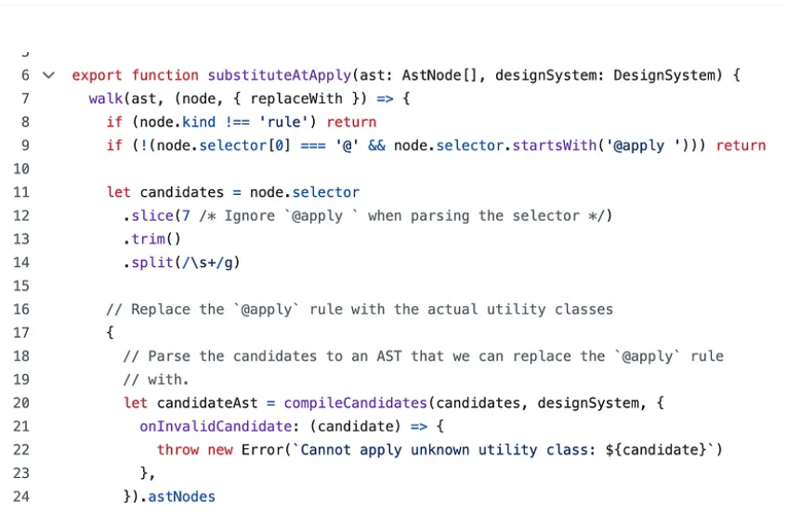Tailwind CSS 如何检测循环依赖。
- Patricia Arquette原创
- 2024-10-09 06:19:02853浏览

在本文中,我们分析了stituteAtApply中抛出的错误。此错误与检测到的循环依赖有关。
walk(rule.nodes, (child) => {
if (child !== node) return
throw new Error(
`You cannot \`@apply\` the \`${candidate}\` utility here because it creates a circular dependency.`,
)
})
这是围绕此错误的代码的高级概述。
walk — 递归函数:
让我们从步行开始:
export function walk(
ast: AstNode[],
visit: (
node: AstNode,
utils: {
parent: AstNode | null
replaceWith(newNode: AstNode | AstNode[]): void
context: Record<string, string>
},
) => void | WalkAction,
parent: AstNode | null = null,
context: Record<string, string> = {},
) {
for (let i = 0; i < ast.length; i++) {
let node = ast[i]
// We want context nodes to be transparent in walks. This means that
// whenever we encounter one, we immediately walk through its children and
// furthermore we also don't update the parent.
if (node.kind === 'context') {
walk(node.nodes, visit, parent, { …context, …node.context })
continue
}
let status = visit(node, {
parent,
replaceWith(newNode) {
ast.splice(i, 1, …(Array.isArray(newNode) ? newNode : [newNode]))
// We want to visit the newly replaced node(s), which start at the
// current index (i). By decrementing the index here, the next loop
// will process this position (containing the replaced node) again.
i -
},
context,
}) ?? WalkAction.Continue
// Stop the walk entirely
if (status === WalkAction.Stop) return
// Skip visiting the children of this node
if (status === WalkAction.Skip) continue
if (node.kind === 'rule') {
walk(node.nodes, visit, node, context)
}
}
}
walk 是位于 ast.ts 中的递归函数。
当node.kind === ‘context’或当node.kind === ‘rule’时,它会递归调用自身,破坏条件基于状态
// Stop the walk entirely if (status === WalkAction.Stop) return // Skip visiting the children of this node if (status === WalkAction.Skip) continue
现在让我们缩小一点,研究一下 apply.ts 中 walk 函数附近的代码
// Verify that we don't have any circular dependencies by verifying that
// the current node does not appear in the new nodes.
walk(newNodes, (child) => {
if (child !== node) return
// At this point we already know that we have a circular dependency.
//
// Figure out which candidate caused the circular dependency. This will
// help to create a useful error message for the end user.
for (let candidate of candidates) {
let selector = `.${escape(candidate)}`
for (let rule of candidateAst) {
if (rule.kind !== 'rule') continue
if (rule.selector !== selector) continue
walk(rule.nodes, (child) => {
if (child !== node) return
throw new Error(
`You cannot \`@apply\` the \`${candidate}\` utility here because it creates a circular dependency.`,
)
})
}
}
})
TailwindCSS 作者在需要时在代码库中添加了解释性注释,或者提供额外的上下文是有意义的
有评论。
关于我们:
在 Think Throo,我们的使命是教授开源项目中使用的高级代码库架构概念。
通过在 Next.js/React 中练习高级架构概念,将您的编码技能提高 10 倍,学习最佳实践并构建生产级项目。
我们是开源的 — https://github.com/thinkthroo/thinkthroo (请给我们一颗星!)
我们还提供网络开发和技术写作服务。请通过hello@thinkthroo.com联系我们了解更多信息!
参考文献:
https://github.com/tailwindlabs/tailwindcss/blob/next/packages/tailwindcss/src/ast.ts#L70
https://github.com/tailwindlabs/tailwindcss/blob/c01b8254e822d4f328674357347ca0532f1283a0/packages/tailwindcss/src/apply.ts
https://stackoverflow.com/questions/71669246/need-help-using-apply-directive-in-tailwind-css
https://github.com/tailwindlabs/tailwindcss/issues/2807
以上是Tailwind CSS 如何检测循环依赖。的详细内容。更多信息请关注PHP中文网其他相关文章!

